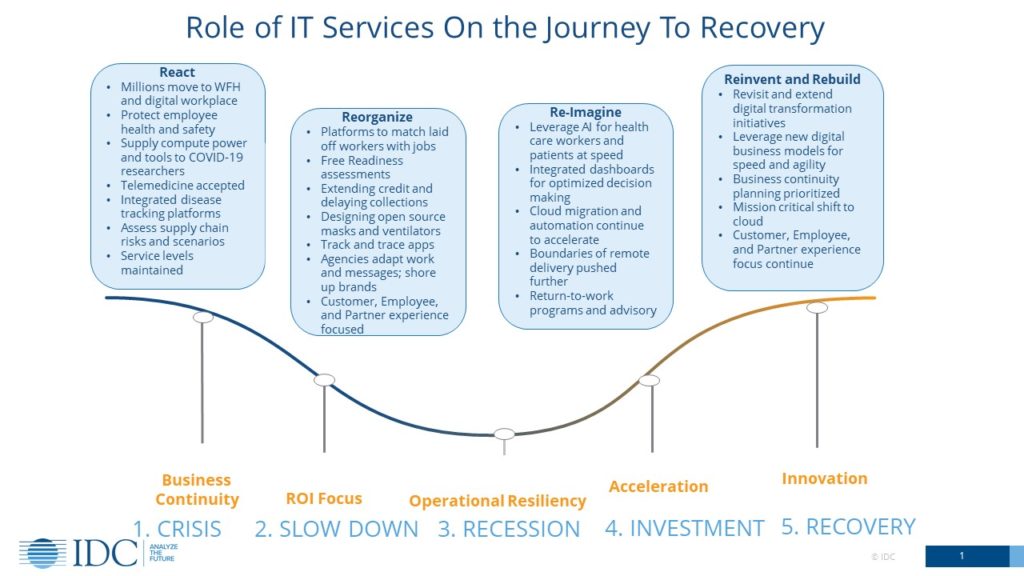Our world has been facing and will continue to face unprecedented times as we battle a global pandemic. The actions needed to temper the devastating effects of the pandemic have in turn led to shutdowns of economies across the globe, massive unemployment, and global recession. The pandemic is still in charge, leading to uncertainty and worries as restrictions are lifted and economies reopen.
According to IDC’s surveys, two-thirds of enterprises with over 1,000 employees utilize the services of professional services firms. How will those firms fare during the different phases of the crisis, from shut down to recovery? In a nutshell, spending on services will decline due to reductions in budgets, requests for price reductions, spending in industries so affected by the pandemic they have to shut down operations, and the need to shift priorities from a growth agenda to cost containment.
But there are things service firms are doing, can do, and will continue to do that will ultimately dictate how not only they’ll emerge but how their customers will emerge when we reach the recovery phase of the economic slowdown we’re in.
The Five Stages of Recovery
Driven by the global pandemic, IDC believes we will go through five phases from crisis to recovery. Each of those phases will have a related business imperative be the primary focus of senior business executives – the CEO agenda if you will. As you can imagine, while these phases will be somewhat unique, different industries and regions will go through these phases at different times, some staying longer in one or another.
During the first phase, the crisis phase, the focus was on business continuity. Most industries and geographies have moved on from this phase. A slowdown has followed as social distancing forced everyone indoors, businesses closed, and unemployment surged. The business imperative turned to ROI, conserving cash for the most critical business activities. We are in or will soon be in recession and the focus becomes operational resiliency, adaptation, and evolution. As we come out of recession and customers begin to spend more, enterprises will ramp up and invest as they begin to accelerate their businesses and services. In time there will be a recovery and at that point, the business imperative will be innovation as companies take what they have learned in the earlier phases and continue towards reinvention.

How IT & Business Services Have Responded
So what does this mean for services companies? Since February or March, when some would say the crisis really began for much of the world including the US, my colleagues and I have been amazed at the role of service firms in supporting most of the activities required to address those early business imperatives. The reality is that service firms are deeply embedded in their clients’ businesses, programs, transformations, and capabilities and will continue to be if these clients are to survive. Business and IT processes are regularly modernized and managed by service firms. Business and IT strategies are developed with service firms. The road to recovery by many, many companies will include service firms.
What have service firms have been doing and what role will they play during each phase of the journey to recovery, starting with the crisis phase? We’ve outlined the following responses:
React
We call this first phase React, as service firms moved millions of their own and their clients’ workers to work from home, implementing millions of instances of cloud based digital workplace solutions. They supported employee health and safety programs and supplied compute power and critical tools to COVID researchers. They spun up telemedicine capabilities and all the many communication capabilities needed to support the initiative. They launched integrated disease tracking platforms combined with economic and client business data to help give better line of sight by leveraging analytics and AI. They helped to assess supply chain risks, develop scenarios, and implement new and alternative networks for their clients. And all this while moving their own workforces, often center based to a work from home basis with the goal of maintaining service levels.
Reorganize
Service firms helped their customers reorganize during the slowdown phase and begin to adjust to the new business and socioeconomic climate. One service firm built a platform along with ecosystem partners and clients to help match laid off workers with jobs in companies in short supply of workers. Many have developed tools to help companies assess their readiness to deal with the pandemic and offered suggestions on what to think about by industry. They’ve extended credit and delayed collections.
They have developed N95 masks and made plans available on an open source basis. Same with ventilator designs of various types. They’ve built track and trace apps. Digital agencies have diverted their clients’ spending from traditional sports advertising to charitable ventures and built brand campaigns while working from home offices using materials from the public domain, or unused from prior projects. These practices would never have been accepted in the past.
They coached their retail clients on how to implement curbside pickup – something that may have taken 9 months of pilots in the past at one or two stores, but now has rolled out in a week. During this phase and truly throughout the journey to recovery, the plan must center around customer, employee, and partner experience. As we’ll discuss later, this is the key for service firm success.
Re-Imagine
As we enter recession and thoughts of post-recession, we enter a phase we call Re-imagine, where services companies help their clients leverage AI for health care workers and their patients at speed; where integrated dashboards offer clues on what geographies or industries will recover first and what they will need. Services will ramp up their work even faster in migrating to the cloud and automating for efficiency and help their clients push the boundaries of remote delivery even further. They’ll help to determine which of these remote activities, launched in a time of crisis, should stick around and be instantiated as innovation. Service firms will help with return to work programs and advisories.
Re-Invent and Rebuild
Finally, as we reach the recovery stage, Service firms will help companies Re-invent and Rebuild, and digital and remote initiatives will be extended. One of the questions I’ve been asking in the numerous briefings I’ve had with service firms is what activities were shifted to remote, for example, due to the pandemic will stick around. One of the more consistent responses has been that the need for face to face presence in deal negotiations or consulting sessions could be reduced. Several have noted surprise that you could actually negotiate fairly large deals via video conference. So new business models depending on digital will be the norm, more and more mission critical workflows will move to the cloud, all while continuing to focus on customer experience, employee experience, and partner experience as the centers of gravity.
The bottom line is that market spending will decline, as will margins. Some buyers have already asked to renegotiate contracts; some want to postpone or even cancel or seek to spend their money in an area that can show a shorter ROI. Most will want to focus on business stabilization and cost containment.
Organizations are a lot more willing to listen to innovative ideas that will help them continue to run their businesses in a “touch-less” fashion and service firms will be an important source of that innovation. For service firms, market share should be the name of the game with a strong focus on maintaining excellent client, employee, and ecosystem relationships. When we look back at 2008-2009, the companies that focused on these critical elements came through a lot stronger than companies that did not.
Our advice is to support your clients and employees, support your communities. Strengthen and leverage your core digital business. Keep the messaging lights on. Let us know all the good things you are doing. Keep your clients optimistic if you can. Take advantage of their open mindedness around digital transformation because as we know if this pandemic has given us anything, it’s given us digital transformation at scale.
Further examine the impact of the COVID-19 pandemic on IT and business services and explore more of IDC’s recent buyer survey results and recommendations for service providers with IDC’s “Impact of COVID-19 on the Services Industry” on-demand webinar:




